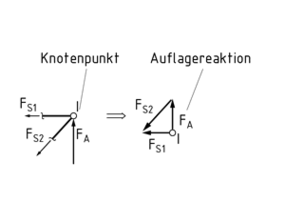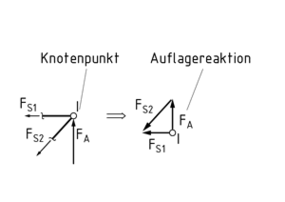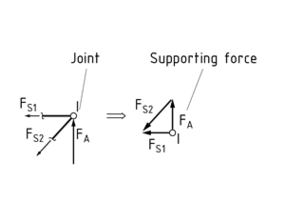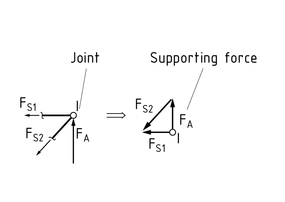
Seleccione uno
o más idiomas
0,1,3
- Alemán
- Inglés
- Chino
- Español
Método de los nudos

El método de los nudos se usa para determinar las fuerzas de los miembros individuales en las armaduras estáticamente determinadas.
Cuando se aplica este método, cada nudo en la armadura se separa de los miembros conectados en un diagrama de cuerpo libre. Las fuerzas de los miembros se dibujan en el diagrama como flechas de vector que apuntan en dirección contraria al nudo (representado por un punto). Estas se consideran fuerzas de tensión. Las fuerzas de los miembros diagonales en una armadura de nivel pueden desglosarse en sus componentes horizontales (dirección x) y verticales (y).
Aplica lo siguiente: ${{F}_{sx}}={{F}_{s}}\cos \alpha $ y ${{F}_{sy}}={{F}_{s}}\sin \alpha $, donde $\alpha $ es un ángulo agudo en el eje x.
Después de determinar las fuerzas de soporte de la armadura, las fuerzas de los miembros son calculadas para cada nudo usando las condiciones de equilibrio para las tres dimensiones. Si el resultado de una fuerza de miembro es negativo, el miembro es un miembro a compresión. Si la fuerza del miembro es positiva, es un miembro a tensión.
Método de los nudos siendo aplicado a un nudo
Knotenschnittverfahren

Das Knotenschnittverfahren ist ein Verfahren zur Ermittlung der Stabkräfte eines statisch bestimmten Fachwerkes.
Jeder Knoten des Fachwerkes wird dabei von seinen angreifenden Stäben freigeschnitten. Von dem Knoten (als Punkt dargestellt) wegzeigend sind die Stabkräfte als Vektorpfeile einzutragen. Sie werden als Zugkräfte angenommen. Schräg verlaufende Stabkräfte in einem ebenen Fachwerk können in ihre horizontalen (x-Richtung) und vertikalen (y-Richtung) Komponenten aufgeteilt werden.
Es gilt: ${{F}_{sx}}={{F}_{s}}\cos \alpha $ und ${{F}_{sy}}={{F}_{s}}\sin \alpha $, wobei $\alpha $ der spitze Winkel zur x-Achse ist.
Unter Verwendung der Gleichgewichtsbedingungen für alle Raumrichtungen errechnen sich die Stabkräfte knotenweise, nachdem die Auflagereaktionen des Fachwerkes bestimmt wurden. Ist das Ergebnis der jeweiligen Stabkraft negativ, so ist der jeweilige Stab ein Druckstab. Ist die Stabkraft positiv, so handelt es sich um einen Zugstab.
Method of joints

The method of joints is used to determine individual member forces in statically determined trusses.
When applying this method, each Joint in the Truss is separated from the connected members in a free body diagram. The member forces are drawn onto the diagram as Vector arrows pointing away from the joint (represented by a dot). They are viewed as tensile forces. Diagonal member forces in a level truss can be broken down into their horizontal (x direction) and vertical (y direction) components.
The following applies: ${{F}_{sx}}={{F}_{s}}\cos \alpha $ and ${{F}_{sy}}={{F}_{s}}\sin \alpha $, where $\alpha $ is the acute angle to the x axis.
After determining the supporting forces of the truss, the member forces are calculated for each joint using the conditions of Equilibrium for all three dimensions. If the result for a member Force is negative, the member is a compression member. If the member force is positive, it is a tension member.
节点法

使用节点法可以确定静定桁架中每个杆件所受的力。
使用节点法时,受力分析图中桁架上的每个节点都要与接触的杆件分离。受力图中杆力都以背离节点(以点的形式表示)的矢量箭头来表示。它们被看作拉伸力。水平桁架上三角构架所受的载荷可以分解为横向( x 方向)和纵向( y 方向)部分。
应用如下: ${{F}_{sx}}={{F}_{s}}\cos \alpha $ 和 ${{F}_{sy}}={{F}_{s}}\sin \alpha $,$\alpha $ 为以 x 轴为参照的锐角。
在得到桁架的支撑力后,杆力可由每个节点在三维方向的平衡条件计算得到。如果所得结果为负,说明此杆为压杆,相反则为拉杆。
节点法也可应用于一个节点
